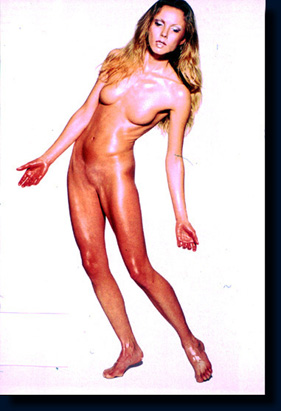

Their idols are silver and gold, the work of mens hands. They have mouths, but they speak not: eyes have they, but they see not: They have ears, but they hear not....feet have they, but they walk not: neither speak they through their throats. They that make them are like unto them; so is every one that trusteth in them.
-Psalm 115
Electronic photo-manipulation is almost by definition a commercial procedure. Because of this hegemonic condition, the marginal usage of electronic photography in the creation of gallery art offers a leverage point for critical investigation. Dutch artist Inez van Lamsweerdes work is particularly provocative in this context, as she is both a magazine fashion photographer and a studio artist. Her gallery pictures hinge on a referencing of commercial codes, particularly those of womens consumerism. Her work is populated by models who have become disjoined from any identifiable product. Her images are the inverse of Warhols Brillo boxes and Campbells cans. The play of coercion and anxiety which underlies the advertising format persists, however, in that it seems to have been absorbed into the figures themselvesto have become embodied.Pictures
In the 1993 work Thank you Thighmaster van Lamsweerde constructed a series of life-size figures by digitally combining photographs of human female models and the heads of shop mannequins. All traces of body hair and sexual organs are erased. The procedure is a kind of vacillating electronic skin graft with the human features overlaid upon the artificial and the mannequin image then finally superimposed.
This multiple layering creates the uncanny effect of fusion (set in motion in film or video, this is the phenomenon of morphing). The resulting recombinant images are at once intensely static and energetic, with the de-sexed body still marked by vein and muscle and the face at once vacant, abstracted, and realistically fleshed. The figures (images) are each named with the tautologous monikers of the iconic supermodel or pop star (Iman, Madonna).
This picture, Britt, like all in the series, shows the figure against a blank field with the body appearing cut out except for tight black shadows under the feet, barely signifying a standing posture. The stance is strangely classical, a sweeping yet reposed contraposto with arms held slightly outward, palms forward, as in display or supplication. The eerily overdefined eyes of the composite face are cast down. Although the distorted nudity, the modernity of the streamlined body, and the make-up tones of the face signal a contemporary vision of physical values, the posture and absence of context lend the figure an ambiguous (art)historical iconicity as somehow Mary-like, an uneasy archetype of the feminine. Heightening the ambivalence between natural and artificial, lived body and model, are the unmarred but animate flesh, the taut bare skin between the legs, which is not void but swells and reveals the pubic bone, the nipple-less beasts, otherwise untampered, and perhpaps most subtly, the high-gloss finish of the nakedness. It is as if the final grafting onto the figure were the sheen of luminous photographic paper itself. This last fetishistic trope is disrupted, however. The hands and feet of Lamsweerdes figure are reddened and raw and seem slicked with shiny lotion, emphasizing creases and veins. The tanning-oil shimmer which signifies luscious health in advertisings terms seems here to be a sort of clinging afterbirth in electronic space, a vestige of slimy corporeality (Also vestigal is the navel, which makes the figure appear to be at some terrifying intermediate stage in the hyper-rapid evolution out of sex, with traces but no function.) This internal collapsing of the fetish-circuit wherein gloss becomes unction is announced by the body as a whole.
This is the literalization of lack, in Christian Metz terms, the closure of the primal displacement of the look between the seen absence and the presence nearby. There is no sustainable presence and no nearby. There is no fetish. At the same time, there is only fetish, the hairless glow of the Coppertone body, discretely sealed. The question, then, is one of positioning. Are these imagings of the narcotized self-amputation of the media-society subjectthe sanitized self-devouring Eric Michaud points to as the madness of techno-capitalist time?
Or are they simply an (un)natural extension of the aesthetic
of tabloid airbrushing Aliens Abducted My Wife?